Optimal Bath Mat Placement: Functionality Meets Style
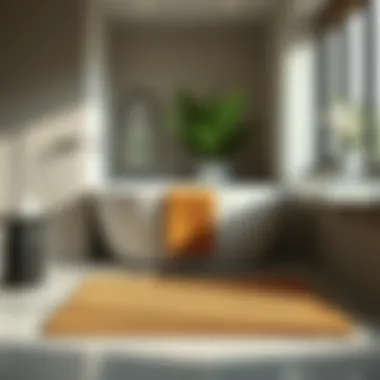
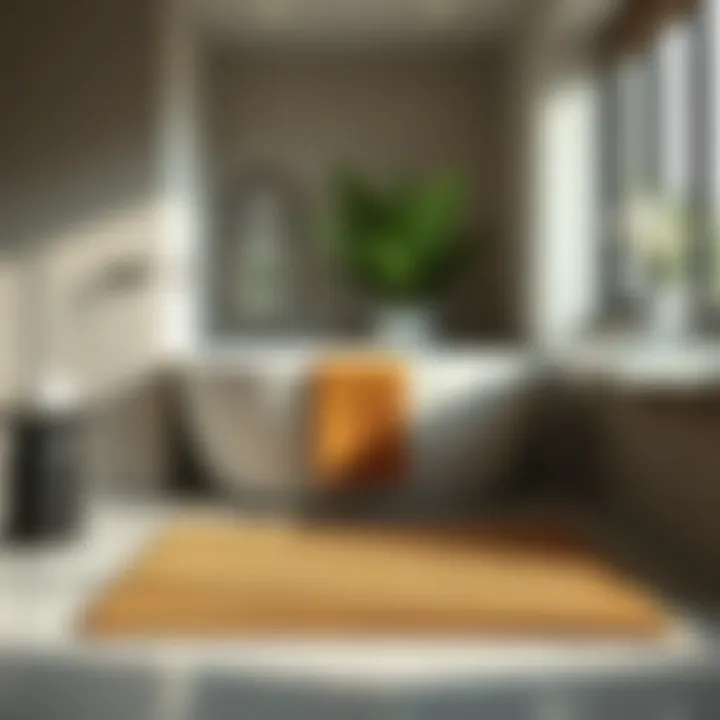
Intro
In the intricate dance of home decor, the bathroom often gets sidelined. Many homeowners view it primarily as a functional space rather than one worthy of aesthetic consideration. Yet, with a few thoughtful choices, a simple bath mat can elevate both the comfort and visual appeal of this essential room. This guide explores how the strategic placement of bath mats can bring together functionality and beauty, transforming an ordinary bathroom into a soothing sanctuary.
The Importance of Bath Mat Placement
When thinking about a bath mat, one might overlook its impact. A bath mat is not merely a piece of fabric laid on the floor; it serves crucial roles—preventing slips, absorbing water, and adding a touch of style to the room. However, where you place this mat can influence these aspects significantly. The right positioning can dictate the flow of the bathroom, enhance safety, and highlight design elements in the space.
Design Inspiration
Trending Styles
In the world of interior design, bath mats have evolved from plain and functional to stylish and diverse. Consider these trending styles that can complement any bathroom:
- Organic Textures: Mats made from natural materials like jute or bamboo can create a serene atmosphere, perfect for a spa-like retreat.
- Minimalist Designs: Simple, monochrome mats can provide a clean and contemporary feel, fitting seamlessly into modern spaces.
- Bold Patterns: For those who want to make a statement, opt for mats with vibrant colors or distinct prints. These can serve as a focal point in an otherwise subdued bathroom.
Color Palettes
Color selection can have a profound impact on the overall ambience of the bathroom. A well-chosen palette can create warmth or promote relaxation. Here are some options to think about:
- Neutral Tones: Shades of white, beige, or gray can create a calm environment, appealing especially in smaller bathrooms.
- Cool Blues and Greens: These colors evoke feelings of tranquility and cleanliness, making them ideal for a refreshing bathroom vibe.
- Vivid Hues: Bright colors like coral, mustard, or teal can infuse energy into the space and can be mixed with contrasting accessories.
Practical Tips
Maintenance & Care
To ensure your bath mat remains in top condition, consider these maintenance tips:
- Regular Washing: Depending on the material, wash your bath mat weekly or bi-weekly to prevent mildew and maintain hygiene.
- Drying: Ensure mats are thoroughly dried post-wash. Moisture can lead to unpleasant odors and bacteria buildup.
- Rotate Mats: Switch out bath mats periodically so that one becomes worn out while the other remains fresh and vibrant.
Budgeting & Planning
Bath mats vary in price, from economical options to high-end designer brands. Planning can help you make a smart choice:
- Set a Budget: Define how much you're willing to spend before shopping. It keeps the wallet in check and helps focus on suitable options.
- Quality Over Quantity: Investing in a high-quality mat may save you money in the long run due to its durability.
- Seasonal Styles: Consider changing bath mats with the seasons for a fresh look without breaking the bank.
"The details are not the details. They make the design." – Charles Eames
Selecting the right bath mat and placing it strategically can dramatically shift the perception and feel of your bathroom. With these insights, homeowners can effortlessly cross the bridge between functionality and aesthetic appeal. Dive into the world of thoughtful design and let your bath mat be more than just a utilitarian piece; allow it to become a cherished part of your bathroom sanctuary.
Understanding Bath Mat Importance
When it comes to designing a bathroom, the significance of bath mats is often overlooked. These seemingly simple accessories can play a crucial role in both the function and aesthetics of the space. Understanding their importance is essential for any homeowner or design enthusiast looking to enhance their bathroom environment.
The right bath mat serves practical purposes beyond mere aesthetics. Consider safety as a primary function. Wet tiles can turn slick quicker than a cat can spring to its feet. A good bath mat absorbs water, providing traction and reducing the risk of slips and falls right after a shower or bath. By ensuring you have the proper mat positioned strategically, you create a safer space not just for yourself but for guests, as well.
Another functional aspect is comfort. Stepping onto a plush mat right after you’ve indulged in a hot shower feels like a welcoming hug for your feet. Materials, like cotton or rubber-backed mats, offer a subtle yet appreciated cushion. This little bit of comfort can transform daily routines into something much more enjoyable.
On the aesthetic side, bath mats are like the final brush strokes in a bathroom art piece. They can tie together the color scheme or add that pop of contrast that sings to the other decor elements. Choosing the right color and design creates a visual flow, making the bathroom not only a necessity but a retreat.
In short, bath mats are essential to enhance both functionality and aesthetics in your bathroom. They provide safety and comfort while contributing to the overall design. Ignoring their importance misses an opportunity for enhancement in both appearance and utility.
"The right mat can turn a utilitarian space into something that feels like a sanctuary."
Homeowners should take the time to consider how the bath mat complements their bathroom before making any selections. From texture to color, the right bath mat will make a whole world of difference in a space that often gets swept aside in the design process.
Determining the Optimal Location
The location of your bath mat might seem like a minor detail, yet its impact can be far-reaching. Proper placement of the mat greatly enhances both functionality and aesthetics in your bathroom. This section delves into vital aspects of determining its ideal position, shedding light on how thoughtful configuration can create a safer, cleaner, and more visually appealing space.
Positioning Relative to Fixtures
When deciding where to place your bath mat, begin with the bathroom fixtures. Consider where you frequently enter and exit, as well as the locations of the shower, bathtub, sink, and toilet. Each component influences both the style and safety of your layout. For instance, placing a mat directly outside the shower or tub is practical, as it catches drips before they reach the floor. Another popular strategy is aligning the mat with the vanity or sink, since this often becomes a high-traffic zone, especially during a busy morning routine.
Moreover, think about the dimensions of the mat in relation to the fixtures. Oversized mats can overwhelm a compact space, while smaller ones feel lost in a grand bathroom. Finding the right size allows for ease of movement without compromising safety.
Key Considerations for Positioning:
- Measure the distance between the mat and fixtures. Ensure there’s enough room to navigate without tripping.
- Take note of mat orientation; sometimes, angle positioning aligns better aesthetically with the room layout.
- Experiment with shapes. A round mat may soften angular lines of your fixtures, creating a more inviting ambiance.
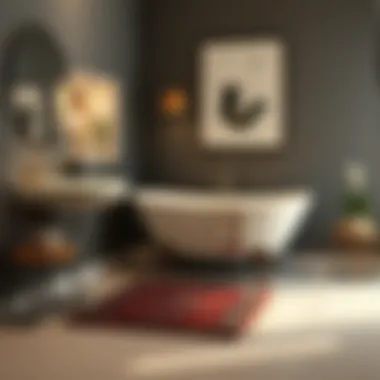
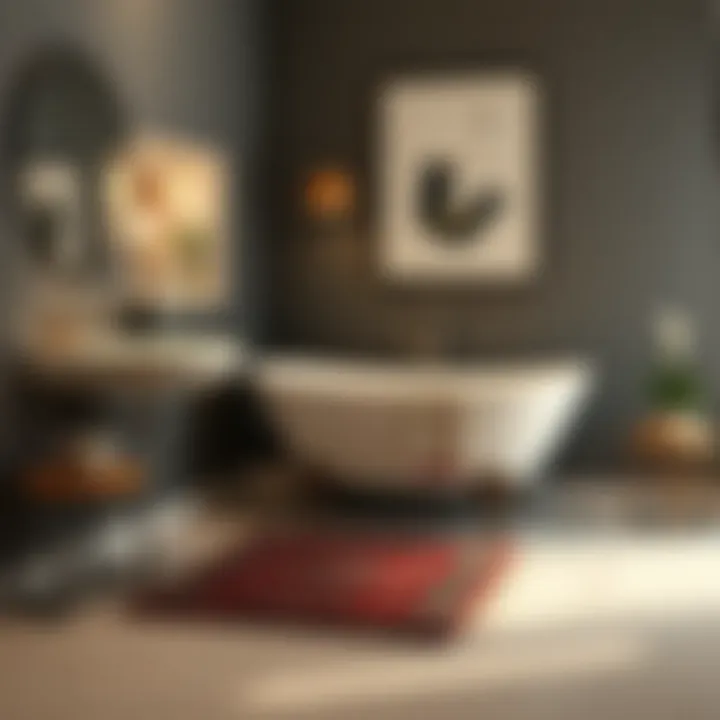
"The best bath mat placement situates it where water escapes while also harmonizing with the room’s layout."
Analyzing Traffic Flow
Bathroom traffic flow involves understanding how people move within the space. Think about the habits of everyone who uses that bathroom, whether it's guests or family members. Do they rush in and out? Or do they linger? Recognizing these patterns is crucial.
Place the mat in areas that facilitate smooth movement, particularly where multiple individuals might cross paths. For example, if travel between the sink and the shower is common, position a mat between those points to prevent slips. It’s essential to observe actual usage before committing to a fixed place.
Moreover, consider the width of the doorway. If the doorway opens into a tight space, placing the mat too close might obstruct passage. In such cases, a vertical orientation might help maximize the effect without crowding the area.
Ultimately, effective traffic flow planning ensures everyone can navigate easily, without the bathroom feeling cluttered or hazardous. A thoughtfully placed bath mat will not only serve its purpose but also enhance the overall experience of using the bathroom.
Traffic Flow Tips:
- Map out movement patterns during peak times (morning, evening).
- Consider installing mats with non-slip backing to enhance safety as people come and go.
- Rearrange furniture and fixtures if necessary, to create a more fluid layout, optimizing movement around the room.
Materials and Their Implications
When it comes to selecting the right bath mat, the material is crucial. The type of material affects not just the aesthetic appeal but also the functionality and longevity of the bath mat. There’s a whole array of options out there, but each material comes with its own set of attributes, making some better suited to specific situations than others. Understanding these materials can save homeowners from making costly mistakes and enhance their bathing experience.
Cotton vs. Microfiber Options
Cotton bath mats have long been a favorite due to their natural feel and absorbent properties. They are soft underfoot and offer a comforting experience right after a shower. However, cotton mats can retain moisture, leading to a shorter lifespan if not regularly washed. On the other hand, microfiber options present a modern alternative. They dry faster and are exceptionally adept at soaking up water without becoming heavy. Still, some might find the texture of microfiber less luxurious compared to cotton.
Key Considerations:
- Comfort: Cotton tends to feel warmer, more plush to many.
- Absorbency: Microfiber often wins for quick absorption.
- Durability: Cotton may wear out quicker with frequent washing.
Water Resistance Attributes
A bath mat that isn't water-resistant can quickly turn into a slippery hazard. To enhance safety and functionality, many modern mats incorporate materials with water-resistant properties. This ensures that water doesn't seep through the mat and collects underneath, which can lead to mold growth over time. Water-resistant mats are not only safer but also maintain freshness longer. People often overlook how important this aspect is. It’s not just about drying off; it’s about ensuring your bathroom stays sanitary.
Essential Points:
- Material Examples: PVC, rubber backing, and treated fabrics are common in water-resistant mats.
- Importance of Airflow: A mat needs air to dry efficiently; select those that promote airflow.
Maintenance Requirements
No one wants to fuss over a bath mat more than necessary. Maintenance is a significant factor when choosing a mat that matches your lifestyle. Cotton mats can be washed regularly but may fade over time. Meanwhile, microfiber versions often boast machine-washable convenience yet require specific drying settings to maintain their plushness.
- Frequency of Cleaning: Aim for at least once a week for mats in frequent use.
- Washing Tips: Cold washes extend longevity, as does avoidance of fabric softeners for both cotton and microfiber mats.
- Drying Methods: Air drying is best for cotton, while low-heat settings suit microfiber mats.
Having the right knowledge of materials and their implications leads to better choices that marry aesthetics with functionality. Whether you lean toward cotton’s warmth or the technological advances of microfiber, understanding materials is a stepping stone to achieving the bathroom sanctuary you desire.
"Choosing the right material for your bath mat is akin to selecting the right foundation for a house; it sets the tone and functionality for everything that follows."
For a comprehensive understanding of bathroom safety and maintenance, visiting reputable health and home improvement sites can be beneficial. Explore articles on sites like Wikipedia or Britannica for more detailed insights.
Placement Strategies for Different Bathroom Designs
Effective bath mat placement can transform a bathroom from a mere functional space into a harmonious retreat. Different bathroom sizes and configurations pose unique challenges, necessitating tailored strategies for placement. The proper positioning not only enhances the visual appeal but also maximizes safety and functionality. Understanding the nuances of different bathroom designs will provide homeowners and design aficionados with the tools to make informed decisions that cater to their specific needs.
Small Bathrooms
In small bathrooms, space is at a premium. The goal here is to make every inch count. Opt for a bath mat that fits well within the design without overwhelming the space. A compact mat can serve the dual purpose of adding comfort while absorbing excess water.
- Choose the Right Size: Select a bath mat that doesn’t extend beyond the edge of the tub or toilet, as that can make the space feel cramped. A mat that’s too large can visually clutter the small area, creating an uncomfortable experience.
- Utilize Vertical Space: Consider hanging decorative hooks or shelves for towels, freeing up floor space for your mat.
- Light Colors: Lighter shades can make a small area feel larger, while a bold mat can be utilized as an accent piece if placed wisely.
Placing the mat directly in front of the sink or tub is usually ideal, as those are the areas most prone to moisture. Ensure that it’s secured in place to prevent any slips and falls—a fundamental consideration, especially in tighter quarters.
Large Bathrooms
Large bathrooms offer a canvas for creativity and comfort. Here, bath mat placement can enhance both functionality and aesthetic appeal without the constraints of space.
- Zoning with Mats: In expansive bathrooms, using multiple mats can define different areas. For example, one mat could be situated near the sink, while another could be placed in front of a bathtub or even a separate shower area. This creates distinct zones for functionality without compromising on style.
- Layering Textures: Consider layering mats with varying textures or styles to create depth. Mixing a plush, larger mat with a smaller, flatter one can add visual interest.
- Decorative Elements: A larger space can handle bolder colors and patterns, allowing the mat to act as a focal point rather than an afterthought.
Positioning mats thoughtfully ensures that they complement existing design elements while providing comfort and practicality, all while avoiding excessive loss of visual continuity within the environment.
Guest Bathrooms
When it comes to guest bathrooms, the aim is to strike a balance between welcoming aesthetics and functional efficiency. After all, making guests feel comfortable during their visits is essential.
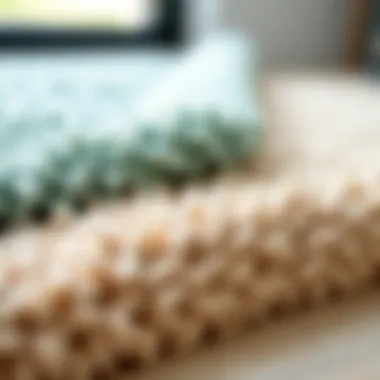
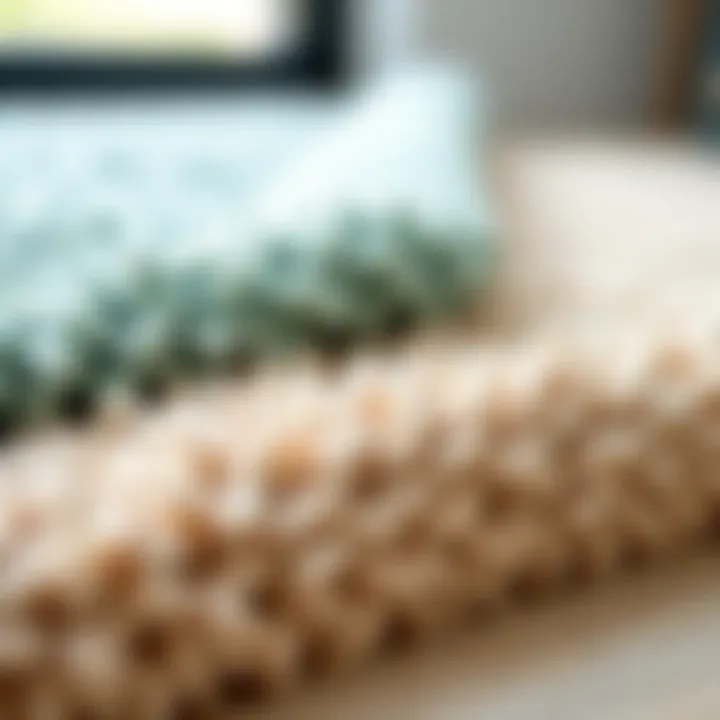
- Neutral with a Pop: Opt for neutral-colored mats that can easily blend with a variety of themes, yet feel free to introduce a striking accent color to inject personality into the space.
- Size Considerations: A standard size that covers enough ground without engulfing the room is ideal. It provides comfort as guests step out of the bath or shower without overwhelming the fixed elements.
- Hygienic Features: Keep in mind that guest bathrooms may see varying levels of traffic. Selecting mats with quick-dry properties or those that can be easily laundered can ensure a fresh feeling for all visitors.
Replacing disposable mats with more sustainable choices may also reflect well on the home's values while maintaining style. For those aiming to leave an impression, consider a unique mat that speaks to the home’s character but remains practical.
Each type of bathroom demands careful thought on how best to integrate a bath mat into the design. It is through mindful selection and placement that a simple accessory can significantly enhance the overall ambiance and functionality.
Common Placement Mistakes
When it comes to arranging bath mats, even minor errors can create considerable drawbacks, both in appearance and safety. Understanding these common placement mistakes is vital for achieving a balance between style and functionality. Disregarding basic principles can hinder the visual appeal of your bathroom and even pose risks to those using the space. Here, we’ll highlight specific decisions that can lead to suboptimal results and how to navigate around them.
Ignoring Size and Scale
One of the biggest pitfalls homeowners encounter is not giving due consideration to the size and scale of the bath mat relative to the bathroom space. A minuscule mat in a spacious bathroom can get lost like a needle in a haystack; conversely, an oversized mat in a compact space can overwhelm the surroundings and create a cramped feel.
- Measure Twice, Place Once: Before purchasing, measure the area where the bath mat will reside. You could jot down measurements or even tape the dimensions on the floor to visualize its impact.
- Consider Fixture Distances: The mat should neither encroach upon nor be too far from critical fixtures like the sink or shower. An ideal placement creates a fluid aesthetic and ensures comfort during use.
In practical terms, a larger bath mat can frame the vanity in a grand bathroom, adding a touch of elegance, whereas in a smaller setting, a well-placed runner can elongate the space visually.
Neglecting Safety Considerations
Safety is another crucial aspect that often falls to the wayside. Bath mats are not merely decorative items, but essential components that can mitigate slip hazards. Forgetting to prioritize grip and placement can create trouble. Here are some primary factors to heed:
- Non-Slip Backing: Always select mats designed with non-slip materials. A bath mat without this feature could easily slide, increase the risk of falls, and create unwelcome accidents. According to the U.S. Consumer Product Safety Commission, slip hazards contribute to numerous bathroom injuries each year.
- Positioning in High-Traffic Areas: Placing a bath mat just outside a shower or tub where water may drip increases its chance of becoming slippery. Consider incorporating adhesive strips or a mat that absorbs moisture quickly as you map out the ideal location.
In addition to safety, consider the overall aesthetic integrity of your bathroom. By placing an adequately sized and safe mat, you not only enhance the style but also safeguard the well-being of your family and guests. As you reflect on common placement mistakes, remember that a well-chosen bath mat can effortlessly blend beauty and safety in your home.
Visual Harmony and Decor Integration
Creating a harmonious visual environment in your bathroom goes beyond mere functionality; it’s about weaving together the elements that make the space feel inviting and cohesive. When selecting and placing a bath mat, considering visual harmony is crucial because it can elevate the entire atmosphere. A well-coordinated bath mat can transform a cluttered or mismatched bathroom into a serene sanctuary, fostering relaxation and comfort for its users. This section highlights how essential elements like color, pattern, and texture converge to create a unified design aesthetic while also underscoring the practical benefits that come from thoughtfully integrating these aspects.
Coordinating Colors and Patterns
Coordinating colors and patterns in your bathroom's design is like conducting an orchestra; each component needs to complement the others to create a melodious result. When choosing a bath mat, it’s important to consider the existing color palette. The mat should either blend in seamlessly or provide a striking contrast that enhances the overall theme.
For example, if your bathroom showcases soft pastel shades, a bath mat in a coordinating soft hue can enhance tranquility. Alternatively, a bold, geometric patterned mat can act as a focal point, drawing the eye and sparking interest without overwhelming the space. When mixing patterns, a good rule of thumb is to keep larger patterns on larger surfaces (like the walls or shower curtain) and reserve smaller patterns for accents like the bath mat. This way, the visual flow remains balanced and appealing.
Some considerations to keep in mind:
- Accent Colors: Look for colors in your bathroom that may only appear in smaller details, like soap dispensers or towels and aim to echo those shades in your mat.
- Color Psychology: Light blues and greens often evoke a sense of calmness, while yellows can create a cheerful atmosphere.
- Contrast Levels: High-contrast combinations can create vibrant energy, while monochromatic schemes lend a more relaxing vibe.
"Choosing the right colors and patterns for your bath mat creates a visual dialogue that connects other elements in your bathroom, creating a cohesive space."
Incorporating Textures
Texture is the unsung hero of bathroom design, bringing depth and tactile interest to a potentially sterile environment. When selecting a bath mat, textures can enhance both comfort underfoot and overall visual appeal. A plush, fluffy mat can imbue a sense of luxury, while a more textured weave can offer a rustic charm that complements natural materials like wood or stone.
Here are some points to ponder when incorporating textures into your bath mat selection:
- Layering Elements: If your bathroom employs different textures—such as a smooth ceramic tile floor, a soft cotton towel, or a sleek glass shower enclosure—consider how your mat's texture will fit. A textured mat can bridge these elements beautifully.
- Functional Textures: Some materials provide better slip resistance compared to others—a crucial consideration for safety in wet areas.
- Climate Considerations: In humid climates, breathable, quick-drying materials are more practical. Textures that absorb moisture, like cotton, can prevent mold and unpleasant odors from accumulating.
Ultimately, blending colors, patterns, and textures creates a bathroom that feels both inviting and functional. It allows homeowners and design enthusiasts to express their personal style while ensuring that all elements work harmoniously together.
Sustainable Practices in Bath Mat Selection
When it comes to picking the right bath mat, just remember that it goes beyond style and comfort; it’s also about being kind to our planet. Sustainable practices in bath mat selection are increasingly important for homeowners and design enthusiasts alike. By choosing eco-friendly options, you not only elevate your bathroom aesthetics but also contribute to a healthier environment. It’s a win-win situation, don't you think?
The trend toward sustainability in bathroom products should not be taken lightly. For those who care about the planet, understanding sustainable materials and manufacturing processes can significantly impact their choices. Because let’s face it, we all want a home that reflects our values. Opting for bath mats that are made from recycled materials or produced by eco-friendly processes can help reduce carbon footprints. Consider this: every small decision adds up, and choosing an environmentally friendly bath mat is just one way to play your part.
Recycled Materials
When discussing materials, recycled options stand out as hero of the day. Mats crafted from fibers created from recycled cotton or plastic bottles are not just good for the Earth—they’re practical, too. Using these types of materials helps reduce waste and keeps useful items out of landfills. You might be surprised to know that some manufacturers employ post-consumer plastics that can save up to 90% of the water typically needed for new fiber production.
Additionally, recycled mats often come in various styles and colors, enabling you to select options that suit your bathroom without compromising on looks.
- Benefits of choosing recycled materials:
- Reduction in landfill waste
- Conservation of resources
- Seven out of ten recycled mats have great absorption properties
Incorporating these mats into your home ensures you’re making a responsible choice while making a style statement.
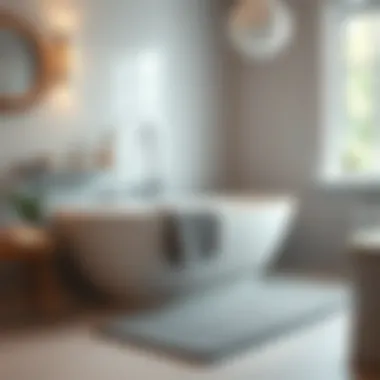
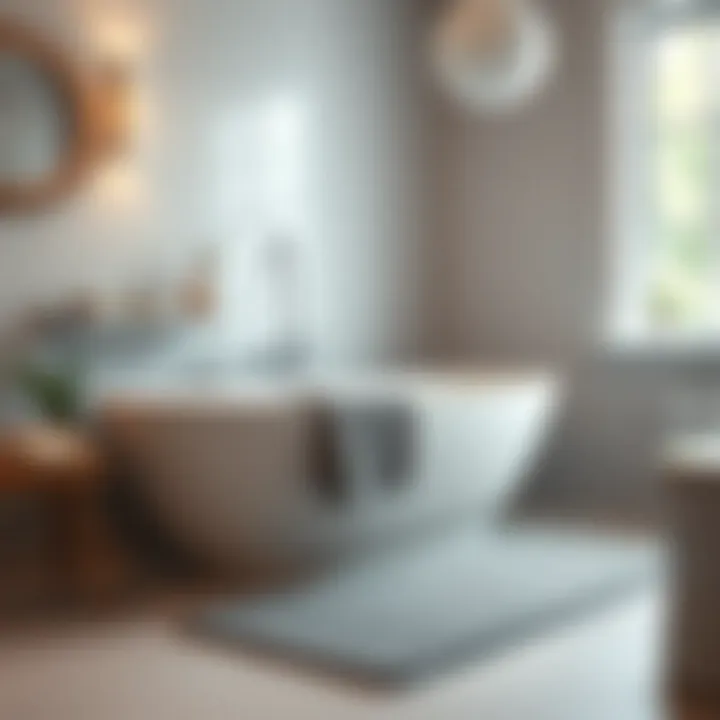
Eco-Friendly Manufacturing Processes
Equally crucial are the manufacturing processes behind these bath mats. Eco-friendly practices can vary widely; however, common threads often include reduced energy consumption and minimal use of harmful chemicals. Companies that prioritize sustainability tend to employ methods aimed at minimizing their environmental impact. It might mean using natural dyes or opting for water-efficient manufacturing processes. The result is a product that not only looks good but feels good knowing it came from a clean process.
"Choosing eco-friendly bath mats means you’re not just enhancing your home’s ambiance, you’re also giving a nod to sustainability."
Moreover, many brands now clearly label their commitment to sustainability, making it easier for consumers to pick options that match their values. This is where research comes in handy, as you might want to look for certifications from recognized environmental organizations, ensuring your purchase contributes positively.
Innovations in Bath Mat Design
In the ever-evolving world of interior design, the bath mat often gets overlooked, yet it serves a dual purpose that can enhance both functionality and aesthetic appeal of the bathroom. Recent innovations have given rise to bath mats that not only do their job of soaking up excess moisture but also possess features that cater to our increasingly busy lives. Understanding these innovations helps homeowners make informed choices that meld effortlessly with modern lifestyles and design trends.
Technological Features
Modern bath mats are now being equipped with a range of technological features designed for convenience and efficiency. For instance, some mats come with built-in sensors that detect moisture levels, signaling when it is time to dry. This can help prevent mildew and prolong the life of the mat.
Another notable development includes heated mats. The warmth they provide can be a true delight on chilly mornings and also help maintain a dry environment, reducing dampness in the air, which can lead to mold growth. Furthermore, smart mats can connect to home technology systems, allowing users to control their bathroom settings through voice commands or smartphones.
Beyond functionality, many of these mats now incorporate antimicrobial coatings, which help keep bacteria at bay, ultimately promoting a healthier environment in one of the most used spaces in a home.
"Innovations aren't just trends – they're solutions that adapt to our lifestyles."
Adaptive Designs for Various Needs
Understanding the diverse requirements of bathroom users informs the design of adaptive bath mats. For families with toddlers or elderly members, slip-resistant mats crafted from durable, textured materials can significantly minimize the risks of falls. The designs now cater to these safety concerns without compromising on style.
For those who have specific aesthetic preferences, there are mats designed to seamlessly integrate into any décor—from minimalist styles to bold, colorful prints. This means that even within functionality, there are options that cater to individual tastes.
Moreover, consideration for those with allergies can also be observed in new designs. Mats made from hypoallergenic materials are becoming widely available, ensuring that comfort does not come at the expense of health. This is particularly useful for creating a serene oasis where the bath becomes a refuge from the outside world.
In summary, the advancements in bath mat design are significant and transformative, marrying practicality with elegance. Observing how these innovations can play a role in enhancing the bathroom experience can lead homeowners to make more informed and beneficial choices.
Seasonal Considerations for Bath Mats
When it comes to bath mats, considering the seasons goes beyond just aesthetics. It plays a crucial role in functionality and maintenance. As the weather shifts, so do our needs, preferences, and even our habits around our bathrooms. Choosing the right mats for the season can not only enhance the look of the space but also improve its usability and hygiene.
Changing Materials and Colors
As the seasons roll in, changing your bath mats can make a significant difference. In winter, thicker, plush mats made from materials like cotton or memory foam can provide warmth and comfort to your feet. Think about how nice it feels to step onto something cozy, especially after a hot shower on a chilly morning. On the other hand, summer calls for lighter materials, such as microfiber or bamboo, which absorb moisture well and feel cooler underfoot.
Colors are another important aspect to keep in mind. Each season naturally brings different palettes that evoke specific moods. In spring, consider soft pastels or floral patterns to mimic the blooming flowers outside. Meanwhile, earthy tones or rich jewel colors could brighten your space in fall, reflecting the changing leaves. Transitioning these elements not only boosts your bathroom's aesthetics but also creates a more inviting atmosphere.
"The colors in our living spaces can influence our feelings and attitudes, so why not extend that mindfulness to our bathrooms as well?"
Using Layering Techniques
Layering bath mats is a technique that can serve multiple purposes, playing beautifully into seasonal changes. By placing a larger, more absorbent mat underneath a smaller decorative mat, you get the best of both worlds. For instance, a robust bath rug could act as a base during the colder months, while a colorful, thinner mat on top could add a pop of personality.
In summer, you could reverse this method—using just a small, lightweight mat that’s easy to wash and dry, ensuring you don’t track moisture around when it’s hot outside. Furthermore, layering enables you to mix and match textures and colors, seamlessly adapting to the seasonal shifts without a complete overhaul. You might even play with textures; a soft cotton mat layered over a braided jute mat might just add that extra flair and warmth during the cooler months.
Incorporating seasonal changes into your bath mat strategy can not only preserve the functionality of your space but also keep your environment fresh and aligned with the changing world around you.
Future Trends in Bath Mat Design and Placement
As we progress further into the realm of interior design, the focus on bath mat placement is evolving beyond mere functionality. This section will discuss the emerging trends that are currently shaping the designs and placements of bath mats, placing emphasis on and . Understanding these trends is crucial for homeowners and design enthusiasts alike, as they not only reflect aesthetic preferences but also cater to convenience and efficiency in modern bathrooms.
Minimalist Approaches
The contemporary trend toward minimalism has a profound impact on bath mat design. Homeowners today seek simplicity and tranquility within their spaces. Bath mats that embody clean lines, neutral colors, and understated textures align perfectly with the principles of minimalism.
Consider opting for mats made from natural materials like bamboo or sustainably sourced cotton. These options not only look sleek but also promote an eco-friendly ethos. Minimalist bath mats can vastly enhance the visual appeal of a bathroom, highlighting the surrounding decor rather than clashing with it.
When implementing a minimalist approach, here are a few guidelines to keep in mind:
- Choose Solid Colors: Simple shades such as white, gray, or beige can create a calm environment.
- Focus on Texture: Instead of bold patterns, go for mats with subtle textures that add depth without overwhelming the senses.
- Size Matters: Select mats that don’t overpower the space; they should complement, not dominate.
Smart Home Integration
As homes become more technologically advanced, integrating bath mats into smart home systems is becoming increasingly popular. Imagine a bath mat that not only absorbs water but communicates with your smart home devices to enhance safety and convenience. For example, bath mats equipped with sensors can detect moisture levels and send notifications to your smartphone if they become excessively wet, potentially preventing slips and falls.
Some innovative designs even include self-drying features, ensuring that your mat remains fresh and free of mildew. As technology advances, the possibilities for intelligent bath mat designs are virtually endless. Here’s how to embrace smart home integration:
- Explore Moisture Detection Mats: These mats alert you if they remain damp for too long, increasing safety in your bathroom.
- Consider Temperature Control Features: Smart mats can help regulate warmth, making stepping out of a shower more comfortable.
- Voice Activation Compatibility: Allow your mat to connect with devices like Amazon Alexa or Google Home for a seamless user experience.
"The future of bath mat design lies in combining functionality with cutting-edge technology, aimed at enhancing user experience."
Adopting these trends not only elevates the aesthetic of a bathroom but also enhances the safety and convenience of daily routines. By incorporating minimalist designs and embracing smart technology, homeowners can create spaces that are both visually appealing and practical, embodying the best of modern living.















